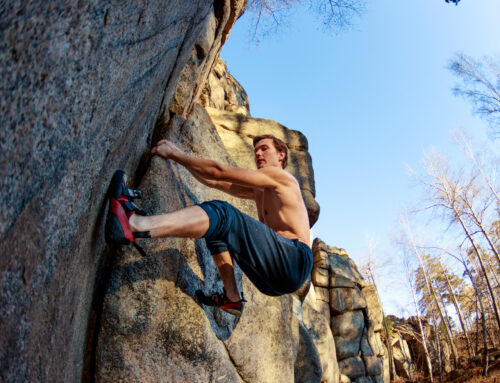Updated July 15, 2022
An increasingly trendy sport, bouldering is a style of rock climbing that’s a great way to get exercise, make new friends, and explore the outdoors. Challenging, fun, and thought-provoking, bouldering requires a perfect blend of physical strength and mental acumen. So…what is bouldering, exactly? Our guide explains all.

What is Bouldering? An Introduction
Whether you’re brand new to climbing or you’ve got top roping and lead climbing under your belt and want to try something new, bouldering is an excellent new outdoor activity to try with friends or on your own in any city.
At its core, bouldering is climbing rocks without the use of ropes or harnesses.
What this translates to in reality is relatively short climbing routes that aren’t far from the ground, and are protected by a crash pad and sometimes a spotter. Climbing without ropes may sound freaky, but with the right gear and preparation, it can be a fun and fairly safe outdoor sport for all.
Indoors, there are specific sections of a rock gym dedicated to bouldering that are typically 10-15 feet tall and do not have the hardware required for top roping. Outdoors, routes (often called “problems”) are typically located on the base of cliffs or on large boulders and rock formations. In both cases, you’ll find climbers attentively planning out their strategies and creatively using the available holds to get to the top of each problem.
Many climbers are drawn to bouldering because it requires very little gear and typically prioritizes strength, technique, and problem solving over stamina and endurance. It’s often seen as a more mentally stimulating form of climbing than top-roping, capturing the hardest parts of any given climb over the course of just a few vertical feet. It’s not uncommon to work on a problem for days or even weeks before finally completing it!

Why Should You Go Bouldering?
We get a lot of questions about bouldering vs. top roping, and while there are many reasons to love both, here are some of our favorite things about bouldering:
- You’ll learn new skills and work different muscles than top rope climbing. While there’s a lot of crossover between the different styles of climbing, bouldering is unique in that it encapsulates the hardest parts of every given climb. Because of this, climbers often have to come up with clever ways to climb, combining strength and balance in a way that maximizes power on the wall or rock.
- It requires very little equipment. Unlike top rope or lead climbing, you really only need shoes for bouldering. This makes the barrier to entry much lower than for other styles of climbing.
- You don’t need a partner to climb (indoors). With top roping and lead climbing, you’ll always need a partner to belay you. However, bouldering doesn’t require that because there aren’t any ropes. While we’d never recommend climbing outdoors alone, it’s perfectly safe to boulder alone in an indoor facility with crash pads and protective equipment.
- Socializing is easier. Because the walls aren’t that high and you have to take a lot of breaks, it’s a lot easier to talk to others while bouldering. While top roping, it can be much more challenging to hold a conversation because of the physical distance between the climber and the belayer.
- It’s a great way to face your fears. Because you aren’t connected to ropes, many boulderers find it difficult at first to face fears of heights and not being tied in. Falling is common while bouldering, and it can be a bit of a learning curve to get used to falling from the top of a route. However, it’s also a great way to face your fears and build grit and strength.

Where to Go Bouldering
Climbing Indoors
The easiest place to try bouldering in any city is at a climbing gym. Most indoor climbing gyms have at least a small section dedicated to bouldering. Some gyms, like Brooklyn Boulders, are completely dedicated to bouldering and do not offer other styles of climbing.
If you are absolutely committed to bouldering, joining a bouldering-only gym will give you access to the largest number of routes. However, those looking for a wider variety of climbing styles may prefer to opt for a gym that offers top roping and lead climbing as well.
We’d highly recommend starting off in a climbing gym if you want to experience bouldering. Once you feel comfortable with your strength, grip, and footwork, you can move on to try climbing outdoors.

Climbing Outdoors
Once you’ve gotten the hang of bouldering indoors, you can hit up a nearby outdoor bouldering area to test your skills in the wild. You’ll need additional equipment for this, namely a crash pad and approach shoes. Moreover, it’s a good idea to only go climbing outdoors once you feel confident in your strength and falling technique to avoid potential injuries.
NOTE: Always go climbing outdoors with a partner or a group. Other people can spot you, providing an additional level of safety in the case of a fall. It can be very unsafe to go alone, especially if you are less experienced with outdoor climbing.
What to Know Before You Go
While bouldering can seem pretty self-explanatory, there are a few things you need to know before you try it for the first time:
- Learn how to fall before you begin climbing. Falling is a skill in itself when you’re a beginner boulderer, and it’s extremely important to learn how to fall before you start tackling any problems. When you fall, you’ll want to land upright on your feet with bent legs and immediately roll onto your butt/back with your arms pulled in towards your chest. This way, you protect your legs and arms from the impact of your fall.
- Bouldering routes are rated by difficulty. These will typically look like V1-V17, but you may see different rating systems depending on the gym or where you are in the world. We’d recommend starting on VB or V0 routes and working your way up.
- Scan your route, including beginning and end holds. Routes typically consist of holds that are all the same color, and you can only use those same colored holds for both your hands and feet for the duration of the route. Each gym does this a little bit differently, but generally beginning and end holds are tagged or marked in some way. If there doesn’t appear to be an end hold (at the top), the route ends at the top of the wall. Technically, a climber only completes a route once they’ve touched the top hold with both hands.
- Keep your arms straight when possible. This way, you won’t tire yourself out unnecessarily. A lot of beginner climbers tackle routes with bent arms and lose steam before the end of the route as a result.
Basic Climbing Gear You Need
What to Wear
- Climbing shoes – Your shoes are the #1 most important piece of gear that you’ll need to start climbing. A good pair of bouldering shoes fits snugly around your feet, giving you full control of your toes and heels. While many gyms have shoes for rent, we’d recommend buying your own early on if you want to climb regularly. Read our guide to buying your first pair of bouldering shoes here.
- Comfortable, stretchy clothing – You’ll want to wear breathable, stretchy clothing whether you’re climbing indoors or outside. Leggings, shorts, or hiking pants often work well for climbing.
- Approach shoes (for outdoor bouldering) – Approach shoes are a cross between hiking boots and climbing shoes that you can wear when you’re hiking up to a particular set of climbing routes. While these aren’t 100% necessary, they’re a great addition to your climbing gear arsenal if you plan to do a lot of outdoor climbing.
Bouldering Gear & Equipment You’ll Need
- Chalk & chalk bag
- Crash pad (for outdoor bouldering)
- Hiking or climbing backpack

Bouldering Vocabulary 101
You might hear some words around the gym that you’re unfamiliar with. That’s because climbing has its own lingo that’s unique to the sport! While there are tons of slang words used by climbers, here are a few that are most commonly used in bouldering:
- Holds – “Rocks” in a gym where hands and feet are meant to be placed while climbing
- Grades – A difficulty rating for bouldering problems
- Volumes – Changes in wall terrain, e.g., a corner or a crack, that can be used during a climb
- Dyno – Short for “dynamic move;” a move requiring a jump to reach the next hold
- Overhang – A climbing area similar to a cave where climbers must climb underneath the wall (rather than vertically)
- Traverse – A bouldering problem that requires a climber to move sideways rather than vertically
- Flagging – Sticking your foot out onto the wall for balance
- Matching – Putting both hands or both feet into a single hold
- Send – Finishing a bouldering problem without falling
- Route setter – The person at a rock gym responsible for creating and testing bouldering problems
Additional Resources
- Where can you go climbing nearby? Check out our Destinations page for activities near you!
- Need shoes? Here’s our guide to the best bouldering shoes for beginners.
- The American Alpine Club has great educational resources for those interested in climbing outside.







